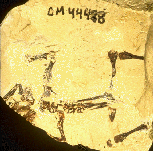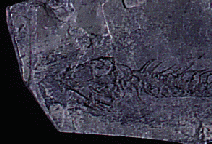



Amphibia: Fossil Record
Click on either small image to download a full-sized version!




Click on either small image to download a full-sized version!

|
The familiar frogs, toads, and salamanders have been present since at least the
Jurassic
Period. (The fossil frog pictured to the left is much younger, coming from the
Eocene,
only 45 to 55 million years ago).
Fossil caecilians are very rare; until recently the oldest known
caecilians were Cenozoic in age (that is, less than 65 million years old),
but recent finds have pushed back the ancestry of the legless caecilians
to Jurassic ancestors that had short legs. The rarity of fossil caecilians is
probably due to their burrowing habitat and reduced skeleton, both of
which lessen the chances of preservation.
|
| The earliest well-known amphibian, Ichthyostega, was found in Late Devonian deposits in Greenland, dating back about 363 million years. The earliest amphibian discovered to date is Elginerpeton, found in Late Devonian rocks of Scotland dating to approximately 368 million years ago. The later Paleozoic saw a great diversity of amphibians, ranging from small legless swimming forms (Aistopoda) to bizarre "horned" forms (Nectridea). Other Paleozoic amphibians more or less resembled salamanders outwardly but differed in details of skeletal structure. Exactly how to classify these fossils, and how they might be related to living amphibians, is still debated by paleontologists. Shown at the right is Phlegethontia, an aistopod from the Pennsylvanian. |

|
Visit the early tetrapod page to find out a bit more on the early evolution of the amphibians and their relatives.

Carroll, Robert L. 1988. Vertebrate Paleontology and Evolution. W.H. Freeman and Company, New York.

